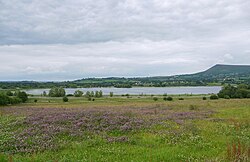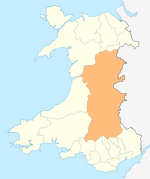Llangorse Lake
| Llangorse Lake | |
|---|---|
 The lake viewed from the southwest | |
| Location | Wales |
| Coordinates | 51°55′51.46″N 3°15′45.92″W / 51.9309611°N 3.2627556°W / 51.9309611; -3.2627556Coordinates: 51°55′51.46″N 3°15′45.92″W / 51.9309611°N 3.2627556°W / 51.9309611; -3.2627556 |
| Lake type | eutrophic glacial natural |
Basin countries | United Kingdom |
| Surface area | 1.53 km2 (0.59 sq mi) |
| Surface elevation | 154 m (505 ft) |
Llangorse Lake (Welsh: Llyn Syfaddon, variant: Llyn Syfaddan) is the largest natural lake in South Wales, and is situated in the Brecon Beacons National Park,[1] near the town of Brecon and the village of Llangors.
The lake is famous for its coarse fishing (particularly pike), watersports, the afanc (nicknamed 'Gorsey') and has the only example of a crannog in Wales. Llangorse Lake is also one of the most mentioned sites in Welsh folklore. It is a site of international conservation importance.
Due to the lake's long history of human activity, it has been known by several different names during its history, both in the Welsh language and in English: other names include the lake's original Welsh name, Llyn Syfaddon/Syfaddan, and Brycheiniog Mere. The name Llangorse Lake is comparatively recent.
Contents
1 Geography
2 Natural history
3 History
3.1 Crannog
3.2 Dugout boat
3.3 Fort
4 Llangorse Lake in literature
5 Gorsey, the Afanc of Llangorse Lake
6 See also
7 References
8 External links
Geography
Llangorse Lake is a eutrophic glacial lake with a 5 miles (8 km) circumference covering an area of 327 acres (1.32 km2). The lake is 1-mile (1.6 km) long and 505 feet (154 m) above sea level.[2] The lake is sited between the basins of the River Wye to the north and the River Usk to the south, and occupies a glacially scoured rock basin partly enhanced by morainic debris.[3] The Afon Llynfi provides the main input of water into the lake and continues as the lake overflow stream. The lake has a maximum depth of 7.5m.[4][5]

Llangorse Lake viewed from Mynydd Llangorse
Natural history
The lake is a Site of Special Scientific Interest (SSSI) and has long been regarded as a place where fish and birds are found in unusually high numbers. Gerald of Wales (Giraldus Cambrensis) mentioned the abundance of waterfowl in his topographical work, The Description of Wales in the 12th century. It is a Special Area of Conservation (under the EU Habitats Directive) as an example of a natural nutrient-rich lake with pondweeds.
The supposed largest pike caught by rod in the UK was caught in Llangorse Lake in 1846 by O. Owen and supposedly weighed 68 pounds (31 kg), but this is unsubstantiated. If true, it would have been the largest pike in the world. The largest pike in the UK was actually caught from Llandegfedd Reservoir near Pontypool and weighed 46 pounds (21 kg). More recently the skull of a pike of unknown weight, though undoubtedly large (35–40+ lb), was found on the shores of the lake in 2004; it was taken away by the Environment Agency for age testing.[6]
The Llangasty Nature Reserve forms an important protected area around the lake's boundary. The lake is a habitat of the Scarce Blue-tailed Damselfly (Ishnura pumilio). In May 2011 hundreds of water voles were released near Llangorse Lake in an ongoing programme to try to restore their numbers.[7]
History
Crannog

The crannog
The crannog is a small artificial island about 40 metres (130 ft) from the north shore. It is constructed of massive planks of oak behind which was built a dwelling platform formed from layers of stone, soil and brushwood.[8] It was investigated by archaeologists from the National Museum of Wales between 1989 and 1993. Finds included a high quality textile and a bronze hinge from an 8th–9th century reliquary decorated in a style similar to that seen in Ireland.[9] The 1993 dig was joined by the TV series Time Team and featured in series one, episode four in 1994.[10] In 2005, works were carried out to protect the island from erosion.[9]
Dugout boat
In 1925, archaeologists discovered a virtually complete dugout boat. Radiocarbon dating indicates that it originated from the 9th century.[8]
Fort
In 916 Æthelflæd, Lady of the Mercians, sent an army into Brycheiniog to avenge the murder of the Mercian abbot Ecbryht and his companions. The Mercian army seized and burnt the royal fort on Llangorse Lake, and took the Queen of Brycheiniog and thirty-three others captive.[11]
Llangorse Lake in literature
As Lake Leucara, the lake (and surrounding area) features in the works of Raymond Williams, who wrote People of the Black Mountains detailing the lives of ordinary people in the area at intervals from 30,000 years ago through to mediaeval times.
In his diary of the 1870s, Francis Kilvert noted several visits to Llangorse Lake, including a July 1878 outing in the company of his father, when the pair caught a brace of perch in an hour.
Gorsey, the Afanc of Llangorse Lake
The earliest known surviving literary reference to the afanc or lake monster of Llangorse is in a poem by the 15th century Welsh poet or bard, Lewys Glyn Cothi (English translation by John Rhys):
|
|
The afanc would have been well known in local folklore at the time of the composition of the poem.
Oll Lewis, an ecologist and cryptozoologist at the Centre for Fortean Zoology, has been studying the Afanc of Llangorse Lake for several years, and has proposed that it may represent sightings of the abnormally large pike of the lake. Adrian Lloyd Jones of the Welsh Beaver Project believes that afanc stories in Wales are folk memories of the presence of beavers. (The modern Welsh word for beaver is afanc).
See also
Llangorse Mountain, British Columbia, Canada
References
^ "Geograph:: Llyn Llangors and the Brecon Beacons (C) Duncan Hawley". Retrieved 30 September 2016..mw-parser-output cite.citationfont-style:inherit.mw-parser-output qquotes:"""""""'""'".mw-parser-output code.cs1-codecolor:inherit;background:inherit;border:inherit;padding:inherit.mw-parser-output .cs1-lock-free abackground:url("//upload.wikimedia.org/wikipedia/commons/thumb/6/65/Lock-green.svg/9px-Lock-green.svg.png")no-repeat;background-position:right .1em center.mw-parser-output .cs1-lock-limited a,.mw-parser-output .cs1-lock-registration abackground:url("//upload.wikimedia.org/wikipedia/commons/thumb/d/d6/Lock-gray-alt-2.svg/9px-Lock-gray-alt-2.svg.png")no-repeat;background-position:right .1em center.mw-parser-output .cs1-lock-subscription abackground:url("//upload.wikimedia.org/wikipedia/commons/thumb/a/aa/Lock-red-alt-2.svg/9px-Lock-red-alt-2.svg.png")no-repeat;background-position:right .1em center.mw-parser-output .cs1-subscription,.mw-parser-output .cs1-registrationcolor:#555.mw-parser-output .cs1-subscription span,.mw-parser-output .cs1-registration spanborder-bottom:1px dotted;cursor:help.mw-parser-output .cs1-hidden-errordisplay:none;font-size:100%.mw-parser-output .cs1-visible-errorfont-size:100%.mw-parser-output .cs1-subscription,.mw-parser-output .cs1-registration,.mw-parser-output .cs1-formatfont-size:95%.mw-parser-output .cs1-kern-left,.mw-parser-output .cs1-kern-wl-leftpadding-left:0.2em.mw-parser-output .cs1-kern-right,.mw-parser-output .cs1-kern-wl-rightpadding-right:0.2em
^ Llangorse lake in the Brecon Beacons national park Archived 2006-11-12 at the Wayback Machine.
^ British Geological Survey 1:50,000 scale geological map sheet 214 Talgarth and accompanying sheet explanation
^ Tristan Hatton-Ellis (1 May 2014). "Lake BAP Priority Areas in Wales – a Strategic Overview". Wales Biodiversity Partnership Freshwater Ecosystem Group and Natural Resources Wales. p. 22.
^ "Llangorse Lake Zones and Contours" (PDF). Lakeside Caravan Park.
^ "Cold Front Zero - Refrigeration Systems". Retrieved 30 September 2016.
^ "Hundreds of water voles released near Llangorse Lake". 7 May 2011. Retrieved 30 September 2016 – via www.bbc.co.uk.
^ ab Keen, Richard and Burgum, Ian. Wales. Orion Publishing Company (1997) pg. 134.
^ ab "Rescuing Llangors Crannog". British Archaeology (84). September–October 2005. Retrieved 2009-08-08.
^ "Prehistoric Britain - Crannogs". Channel 4. Retrieved 2009-08-08.
^ Charles-Edwards, T. M. (2013). Wales and the Britons 350–1064. Oxford, UK: Oxford University Press. p. 505. ISBN 978-0-19-821731-2.
- The Description of Wales by Geraldus Cambrensis at Project Gutenberg
- The Domesday Book of Mammoth Pike by Fred Buller, Hutchinson, 1979 (
ISBN 0-09-136170-2)
External links
- Brecon Beacons national park information at the mountain hut
- S.S.S.I. listing
- 'The Description of Wales' by Giraldus Cambrensis at Project Gutenberg
- www.geograph.co.uk : photos of Llangorse Lake and surrounding area

